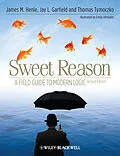Sweet Reason: A Field Guide to Modern Logic, 2nd Edition offers an innovative, friendly, and effective introduction to logic. It integrates formal first order, modal, and non-classical logic with natural language reasoning, analytical writing, critical thinking, set theory, and the philosophy of logic and mathematics.
* An innovative introduction to the field of logic designed to entertain as it informs
* Integrates formal first order, modal, and non-classical logic with natural language reasoning, analytical writing, critical thinking, set theory, and the philosophy of logic and mathematics
* Addresses contemporary applications of logic in fields such as computer science and linguistics
* A web-site (www.wiley.com/go/henle) linked to the text features numerous supplemental exercises and examples, enlightening puzzles and cartoons, and insightful essays
Autorentext
James M. Henle is Professor of Mathematics at Smith College. His books include Calculus: the Language of Change (with David Cohen), Infinitesimal Calculus (with Eugene Kleinberg), and An Outline of Set Theory.
Jay L. Garfield is Doris Silbert Professor in the Humanities and Professor of Philosophy at Smith College, Professor in the Graduate Faculty of Philosophy at the University of Massachusetts, Professor of Philosophy at Melbourne University, and Adjunct Professor of Philosophy at the Central University of Tibetan Studies.
Thomas Tymoczko was, until his death, Professor of Philosophy at Smith College. He was editor of New Directions in the Philosophy of Mathematics.
Klappentext
What exactly is "logic," and how does it work in the real world? Sweet Reason: A Field Guide to Modern Logic, 2nd Edition offers an innovative introduction to the field of logic in all its guises - one that integrates formal first order, modal, and nonclassical logic with natural language reasoning, analytical writing, critical thinking, set theory, and the philosophy of logic and mathematics. Designed to entertain as it informs, this nontraditional yet highly effective approach allows for a richer insights and a deeper understanding of the myriad principles of logic. Contemporary applications of logic in fields such as computer science and linguistics are also addressed. To further enhance clarity, a website linked to the text features numerous supplemental exercises and examples, enlightening puzzles and cartoons, and insightful essays on history, philosophy, mathematics, computing, linguistics, and religion. Sweet Reason brings the discipline of logic into sharp focus as a field of inquiry, not just a body of technique.
Zusammenfassung
Sweet Reason: A Field Guide to Modern Logic, 2nd Edition offers an innovative, friendly, and effective introduction to logic. It integrates formal first order, modal, and non-classical logic with natural language reasoning, analytical writing, critical thinking, set theory, and the philosophy of logic and mathematics.
- An innovative introduction to the field of logic designed to entertain as it informs
- Integrates formal first order, modal, and non-classical logic with natural language reasoning, analytical writing, critical thinking, set theory, and the philosophy of logic and mathematics
- Addresses contemporary applications of logic in fields such as computer science and linguistics
- A web-site (www.wiley.com/go/henle) linked to the text features numerous supplemental exercises and examples, enlightening puzzles and cartoons, and insightful essays
Inhalt
Preface xi
What Is Logic? 1
Chapter One 3
1.1 Introducing Formal Logic 4
1.2 Constants and Relations 7
1.3 Quantifiers and Variables 9
1.4 Introducing Informal Logic 11
1.5 Conclusions 13
1.6 Dialects of Logic 15
Chapter Two 18
2.1 Formal Inference 19
2.2 Informal Inference 21
2.3 Diagramming Arguments 25
2.4 Saying No 32
2.5 Metalogic 35
Chapter Three 37
3.1 Basic Sentential 37
3.2 Truth Tables 43
3.3 English to Sentential 50
3.4 Negating Statements 56
3.5 Rebutting Premises 59
3.6 Computer Logic 65
Chapter Four 69
4.1 Validity 69
4.2 The Logic of English 73
4.3 Negating Conditionals 76
4.4 Rebutting Inferences 80
4.5 The Logic of Sets 87
Chapter Five 94
5.1 Well-formed Formulas 94
5.2 The Shortcut Method 101
5.3 Local and Global 108
5.4 More on Trees 111
5.5 Rebutting Everything 115
5.6 Polish Logic 122
Chapter Six 129
6.1 Predicate 130
6.2 English to Predicate 139
6.3 Reading Between the Lines 145
6.4 Multi-valued Logic 153
Chapter Seven 162
7.1 Universes 162
7.2 Syllogisms 167
7.3 Validity 172
7.4 Diagramming Your Argument 176
7.5 Inductive Logic 187
Chapter Eight 192
8.1 Predicate Wffs 192
8.2 Outlining Your Argument 196
8.3 The Logic of Chance 205
Chapter Nine 213
9.1 Simple Deduction 213
9.2 Simple Strategy 221
9.3 Writing Your Argument 227
9.4 Basic Modal Logic 234
Chapter Ten 240
10.1 Sentential Deduction 240
10.2 Sentential Strategy 250
10.3 Arguing with Yourself 263
10.4 Sophisticated Modal Logic 279
Chapter Eleven 287
11.1 Predicate Deduction 287
11.2 Predicate Strategy 296
11.3 Why We Argue 306
11.4 Presidential Debating 310
11.5 The Logic of Paradox 315
Chapter Twelve 327
12.1 Deduction with Identity 327
12.2 Deduction, FMTYEWTK 332
12.3 Parliamentary Debating 336
12.4 Cathy, A Decade On 338
12.5 Incomplete Logic 343
What is Logic? 349
Answers to Odd-Numbered Exercises 350
Index 384
